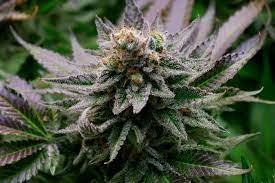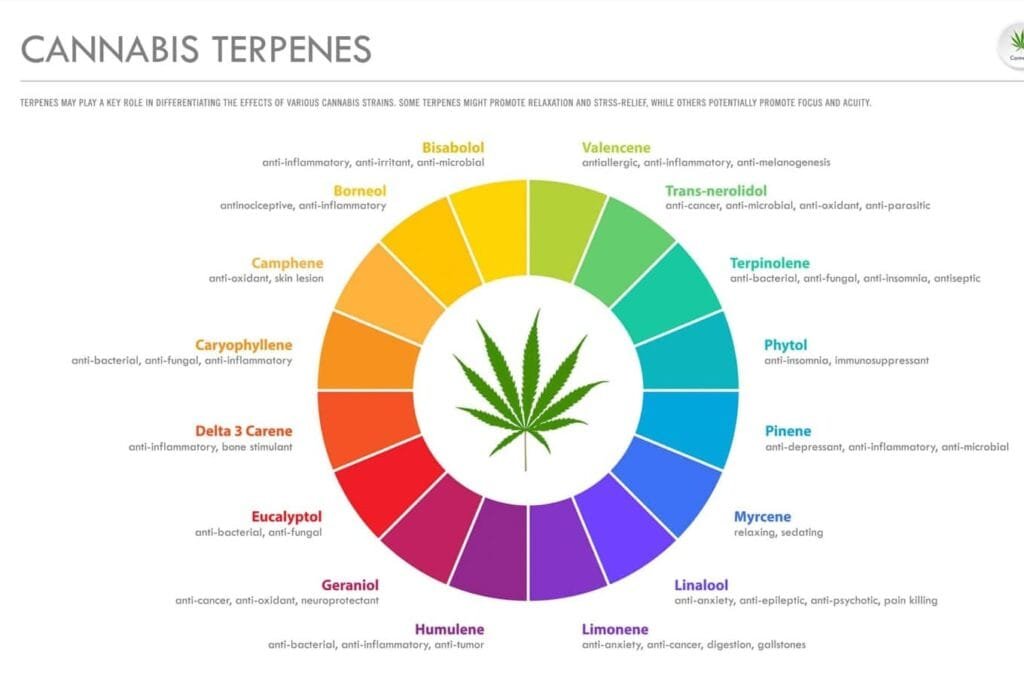Cannabis is more than just THC or CBD. While these cannabinoids do give cannabis the psychoactive and therapeutic properties, there are other crucial constituents. Terpenes are the aromatic compounds that add to the synergy of cannabis extracts. Not only in cannabis, but terpenes are found throughout nature – in fruits, herbs, flowers, and trees.
Terpenes are organic molecules that add the distinctive scents and flavors we associate with different plants. In cannabis products, these molecules work synergistically with cannabinoids to create the “entourage effect.” Here, we share a list of terpenes and their effects to help you improve your selection of cannabis products. When you understand cannabis terpenes and their effects, you can move beyond simply choosing products based on THC percentage.
Sections
ToggleWhy Should You Care About Cannabis Terpenes?

If you know common terpenes and their effects, you can make informed decisions about cannabis products. THC or CBD gives these products the core psychoactive or therapeutic properties, but terpenes add aroma and taste while enhancing therapeutic benefits. When you know different terpenes and their effects, you can select products based on strains that align perfectly with your wellness goals and lifestyle needs.
13 Types of Cannabis Terpenes and Their Effects

Equipment and Materials You'll Need
Terpene | Aroma | Common Effects | Found In | Potential Benefits |
Myrcene | Musky, earthy, herbal | Sedating, relaxing, muscle relaxant | Mangoes, hops, thyme | Sleep aid, pain relief, anti-inflammatory |
Limonene | Citrus, lemon, orange | Uplifting, mood-enhancing, energizing | Citrus peels, juniper, peppermint | Stress relief, mood elevation, antibacterial |
Pinene | Pine, forest, fresh | Alertness, memory retention, focus | Pine needles, rosemary, basil | Cognitive enhancement, bronchodilator |
Linalool | Floral, lavender, sweet | Calming, anti-anxiety, sedative | Lavender, coriander, mint | Anxiety relief, sleep support, anti-seizure |
Caryophyllene | Spicy, peppery, woody | Anti-inflammatory, pain relief | Black pepper, cloves, cinnamon | Pain management, neuroprotection |
Terpinolene | Piney, floral, herbal | Uplifting, creative, slightly sedating | Tea tree, nutmeg, apples | Antioxidant, antibacterial, calming |
Humulene | Earthy, woody, spicy | Appetite suppressant, anti-inflammatory | Hops, coriander, ginseng | Weight management, inflammation reduction |
Bisabolol | Floral, chamomile-like | Soothing, anti-irritant, calming | Chamomile, candeia tree | Skin healing, anti-inflammatory, relaxation |
Eucalyptol | Minty, cool, fresh | Cognitive clarity, energizing | Eucalyptus, tea tree, basil | Mental focus, respiratory support |
Ocimene | Sweet, herbaceous, woody | Uplifting, energizing, decongestant | Orchids, pepper, basil | Mood enhancement, antiviral properties |
Farnesene | Green apple, citrus | Calming, anti-inflammatory | Green apples, gardenia | Stress relief, muscle relaxation |
Geraniol | Rose-like, floral, fruity | Mood-enhancing, neuroprotective | Roses, geraniums, lemongrass | Antioxidant, mood support, antibacterial |
Borneol | Menthol, camphor, pine | Calming, sedative, pain relief | Camphor, ginger, thyme | Pain management, stress reduction |
How to Choose Cannabis Products Based on Terpene Profiles
Now that you know the common types of terpenes and their effects, and how they occur in nature, let’s understand how you can use this information for selecting the right cannabis products.
Why terpene labels matter more than THC % alone
THC percentage is an indication of the potency of the product. However, it’s the terpenes present that define the experience you will have. For instance, a high-THC strain with sedating terpenes like myrcene will produce effects that vastly differ from a product with limonene with the same percentage of THC.
Choosing strains for energy vs. sleep vs. focus vs. anxiety
Not all cannabis products have the same “high,” choose wisely based on what effect you want:
- For Energy: Look for products high in limonene, pinene, or terpinolene
- For Sleep: Seek strains rich in myrcene, linalool, or bisabolol
- For Focus: Choose products featuring pinene, eucalyptol, or moderate terpinolene
- For Anxiety: Opt for linalool, bisabolol, or caryophyllene-dominant profiles
How terpene blends create unique experiences
Rarely a cannabis product will have a single type of terpene. Mostly, producers blend different terpenes for a well-rounded effect. For example, a strain with both limonene (uplifting) and caryophyllene (pain-relieving) might relieve energetic pain.
Tips for beginners on reading terpene lab reports or labels
- Focus on the top 3-5 terpenes listed, as these have the most significant impact
- Total terpene content indicates intensity of effects – higher percentages (above 2%) typically indicate more pronounced effects
- Always research all terpenes on the label to understand their effects
- Begin with products containing familiar terpenes before exploring complex blends
Benefits of Cannabis Terpenes: Health and Wellness Potential
Here’s a list of terpenes and benefits; as the research advances, we are finding more therapeutic advantages of these organic compounds:
1. Anti-inflammatory properties: Terpenes like caryophyllene and humulene have significant anti-inflammatory effects, potentially helping with conditions like arthritis and inflammatory bowel disease.
2. Pain relief: Myrcene and caryophyllene have analgesic properties, offering natural pain management alternatives. Due to such terpenes, cannabis products show particular promise for chronic pain conditions.
3. Anti-anxiety and stress relief: While most terpenes have calming effects, some, like linalool and bisabolol, are particularly useful for managing anxiety disorders and daily stress without the side effects associated with pharmaceutical alternatives.
4. Sleep support: Sedating terpenes such as borneol provide a natural alternative for treating insomnia and improving sleep quality naturally.
5. Antibacterial and antifungal effects: Several terpenes are found to demonstrate antimicrobial properties. It makes them potentially beneficial for immune system function and fighting infections.
Are There Any Risks or Side Effects?
Terpenes are organic compounds that are generally safe, but abuse can lead to potential risks, which include:
1. Generally safe in natural amounts: When consumed in typical cannabis products without concentrating or mixing with other products, terpenes pose minimal risk.
2. Irritation from high concentrations: Concentrated terpene products can result in skin or respiratory irritation, particularly in sensitive individuals.
3. Potential allergic reactions: Individuals with plant allergies must be careful with terpenes as they may experience allergic responses to specific terpenes.
4. Synthetic vs. natural sources: Natural cannabis-derived terpenes are safest. Also, synthetic alternatives lack the full spectrum of beneficial compounds.
5. Importance of quality sourcing: Unregulated markets don’t deliver tested products; they only buy from reputable producers to ensure correct and quality terpene profiles.
Conclusion
As terpenes are the core ingredients of any cannabis product, understanding their effects is essential. The list of terpenes and their effects we shared will put you in an advantageous position to make informed decisions. Whether you’re seeking pain relief, better sleep, enhanced focus, or mood support, do not choose a product solely on strain names or THC percentages; read the label to know the types of terpenes present.




